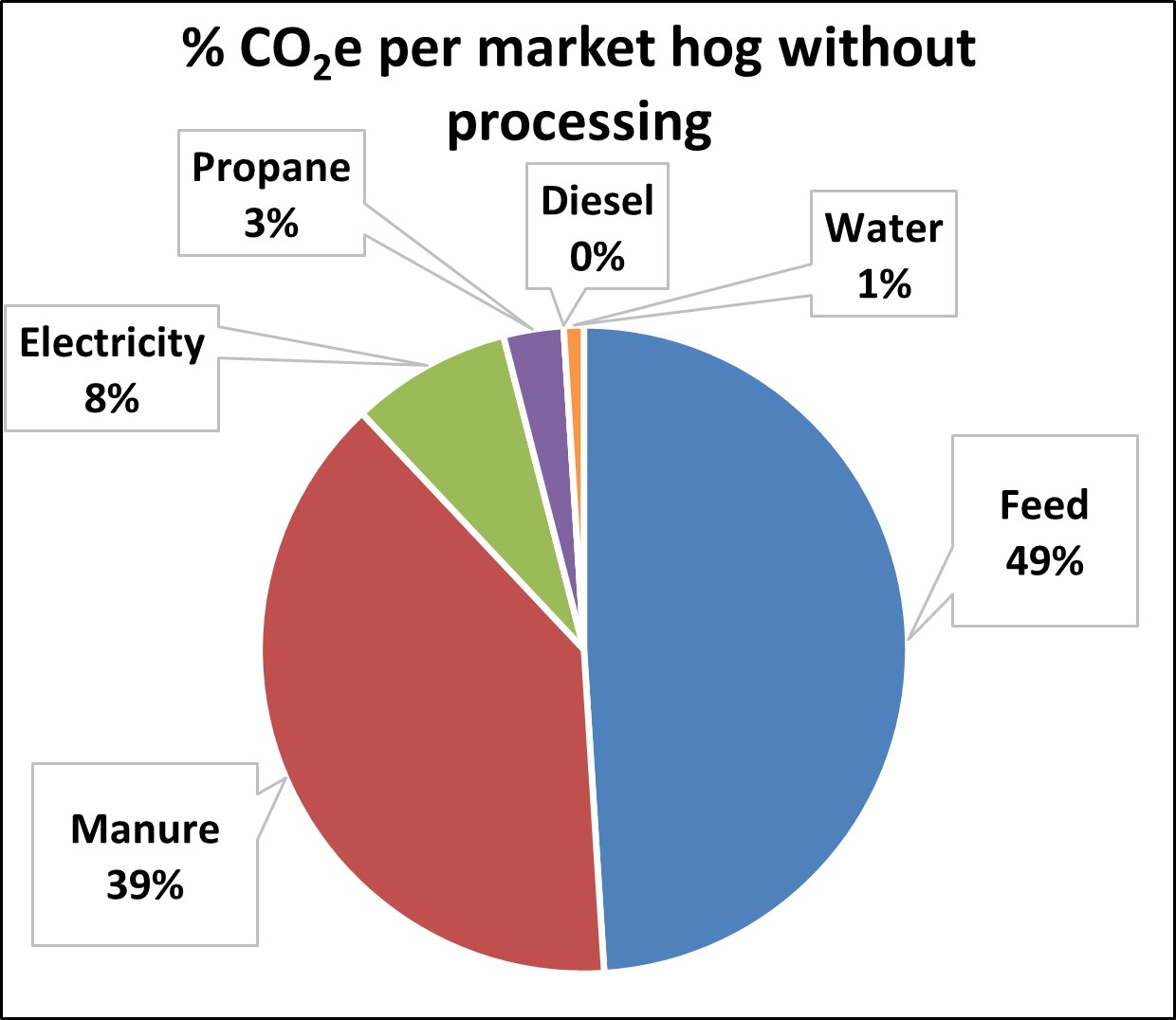
The pork industry is a buzz with carbon reduction goals and even carbon neutrality. Two questions often asked are what is a carbon neutral pig and what can farmers do? A carbon neutral pig has net zero carbon dioxide emission equivalents (CO2e) into the atmosphere during its lifetime. CO2e is a term used to express the impact of multiple greenhouses gases in a common unit of CO2 which would give a single value for global warming potential. The lower the CO2e the more sustainable an operation has become.
In a pig’s lifetime, 88% of the CO2e is represented by feed and manure. When looking further into what causes these numbers to be the driving factors for CO2e it boils down to crops, the associated tillage, and manure management practices. A pig consumes roughly 540 lbs. of corn, 100 lbs. of DDG, and 40 lbs. of SBM. This makes up 96% of their overall feed consumption. Because of the large percentage associated with the three ingredients, it is worthwhile to look further into crop management practices that can help to reduce CO2e of the crops thus lowering the footprint for feed and manure. Below are strategies that farmers may be doing today from a management standpoint that serve as CO2e reduction strategies.
Strategies
Two of the major contributors to the CO2e of pigs are soil nitrogen dioxide (NO2) and carbon dioxide (CO2). Both are major contributors to the overall carbon footprint for the farm and pig.
 Many pig farmers today are using manure (organic fertilizer) to replace synthetic fertilizers. By replacing synthetic fertilizers with 50% manure and utilizing a nitrogen application rate of 132 lbs N/acre, a reduction of up to 66% CO2e has been modeled for a field compared to a typical rate of 200 lbs N/acre with no manure in Southwest Minnesota. An option is also available for those who do not have access to manure in which a reduction of synthetic fertilizer from 200 to 132 lbs N/acre reduced the CO2e of the field by 46%.
Many pig farmers today are using manure (organic fertilizer) to replace synthetic fertilizers. By replacing synthetic fertilizers with 50% manure and utilizing a nitrogen application rate of 132 lbs N/acre, a reduction of up to 66% CO2e has been modeled for a field compared to a typical rate of 200 lbs N/acre with no manure in Southwest Minnesota. An option is also available for those who do not have access to manure in which a reduction of synthetic fertilizer from 200 to 132 lbs N/acre reduced the CO2e of the field by 46%.
A second step that can be taken is the use of carbon considerate tillage practices. Conventional tillage creates the most soil disturbance followed by reduced and no-till. In general, the less soil disturbance that occurs, the lower and better the CO2e for the field. For instance, moving from a conventional to reduced tillage or no till practice can reduce CO2e by 37% and greater than 100%, respectively.
A third step is the incorporation of cover crops into the crop rotation. This strategy can also help improve the soil health by preventing erosion, suppressing weeds, and increasing nutrient management. Cover crops help to hold soil in place during the vulnerable time of year and hold key nutrients in the soil. Improving the soil quality can benefit crop yields, resulting in a more sustainable field. Utilizing cover crops correctly can reduce N needed for the following crop year, thus reducing the CO2e.
Carbon Sink
Combining each of the practices listed before in a field can lead to what is known as a carbon sink. A carbon sink is when a field can hold carbon in the soil that would otherwise be emitted into the atmosphere.1 Reducing tillage practices, and adding crop rotations and cover crops will hold carbon in the soil that would otherwise be emitted. For example, if a field moves from conventional till with synthetic fertilizer to reduced tillage with 50% manure, an 86% reduction in CO2e per field could be achieved thus lowering the carbon footprint. To reduce the footprint even further, no-till can be incorporated with manure and cover crops to achieve over a 100% reduction meaning a carbon sink was created for the field. The reason the sink is important to the field is that it would give a net zero or negative land emission factor for corn and soybeans harvested from the land. This in turn would be factored into the corn and SBM that is processed and used to feed the pigs.
In some cases, farmers are doing one or all the above practices in their fields today. I hope this sheds light on the sustainability side of the equation for those already using these strategies. For those not currently using one of these practices, I hope this helps you to think about adoption of sustainable efforts on your farm.
Sheehan, J.J., et al., 2014. Scenarios for low carbon corn production. https://webdoc.agsci.colostate.edu/soilcrop/ lowcarboncorn/cornfull.pdf
By: Roger Cochrane, PhD Feed Mill Director, Pipestone Nutrition
